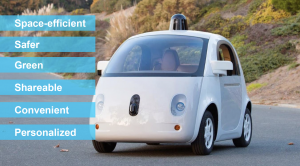The Uncertain Future of Autonomous Vehicles
By TH!NK by IBI
Date
October 20, 2017San Diego recently held an Autonomous/Connected Vehicles Forum. The primary focus of the forum was to grapple with questions about the future- How will land use change with autonomous vehicles? How will these cars be regulated and what new policies will we need? When will CAVs -really- show up on our roads? And perhaps the biggest question of all, underlying all the smaller ones, was is this a dystopian future or an optimistic one?

IBI Group’s Oliver Hartleben presented “Autonomous Vehicles: Impacts on Mobility and Land Use“. Click here for larger image.
The presentations from the event tended towards optimism, if the roll-out of this technology is well managed at the urban scale. In the presentation by SANDAG, they identify both opportunities and risks for the region. While there is the opportunity for CAVs to bring efficiency, social equity, and greenhouse gas reductions, there is also the risk of sprawl, increased vehicle miles travelled, and greenhouse gas increases. Similarly, Susan Shaheen from UC Berkeley, identified induced demand and a potential modal shift away from public transportation as a primary challenge to CAVs. This would also lead to an increase in vehicle miles travelled if policies and planning aren’t quickly put in place. In a The takeaway from the forum was that these challenges are all manageable risks; we will be able to shape a future for AVs that enhances our way of life, rather than diminishing it.
Shared autonomous vehicles will have huge land use implications: unlock land currently used as parking? Increase sprawl? #SDAVforum
— Eduardo Velasquez (@EduardoThinks) September 28, 2017
Hearing from @KomeA from @CaltransHQ about the complex and optimistic future of autonomous vehicles. #sdavforum pic.twitter.com/gfvW6xAH3Q
— Colin Parent (@ColinParent) September 28, 2017
Multiple IBI Group staff members from across North America came out to join this discussion. David Chew, a Transportation Planner in the Irvine office, summarized his own learning from the day:
“One of the biggest takeaways from the CAV forum was the wide range of uncertainty surrounding the eventual arrival of CAVs. It’s not only a part of the transportation perspective, but it’s affecting a wide range of topics including land use, design, safety, technology, economics, etc. The challenge is identifying how to address these questions. And several attendees seemed to support the idea that we rely upon past events of technological advancements to help guide us toward a more sustainable future.”
View all the presentations from the Forum here and check out their curated reading list for more thought leadership on the future of autonomous vehicles.
Photo by Tulen Travel on Unsplash







